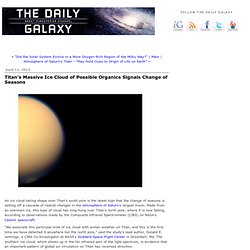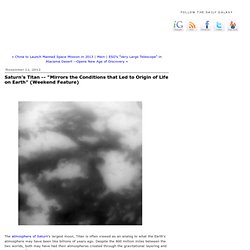

Titan's Massive Ice Cloud of Possible Organics Signals Change of Seasons. An ice cloud taking shape over Titan's south pole is the latest sign that the change of seasons is setting off a cascade of radical changes in the atmosphere of Saturn's largest moon.

Made from an unknown ice, this type of cloud has long hung over Titan's north pole, where it is now fading, according to observations made by the Composite Infrared Spectrometer (CIRS) on NASA's Cassini spacecraft. When Cassini first observed the circulation pattern, warm air from the southern hemisphere was rising high in the atmosphere and got transported to the cold north pole. There, the air cooled and sank down to lower layers of the atmosphere, where it formed ice clouds.
A similar pattern, called a Hadley cell, carries warm, moist air from Earth's tropics to the cooler middle latitudes. Comet rain took life's ingredients to Jupiter's moons - 13 February 2013. Read more: Click here to read a longer version of this story BLACK rain made from pulverised comets may have seeded Jupiter's moons with the raw ingredients for life.

That includes Europa, which is thought to harbour a liquid ocean beneath its icy crust. Jupiter has two kinds of natural satellites: large spherical moons and smaller lumpy bodies that follow elongated orbits. Chemical analysis of the irregular bodies suggests they are made of the same stuff as asteroids and comets. This means they are rich in the carbon-containing compounds that are key to life on Earth. It is thought that a gravitational reshuffling of the planets some 4 billion years ago shook up distant belts of space rocks and sent many of them hurtling towards the sun. Models say that Jupiter should have captured about 70 million gigatonnes of rocky material, but less than half that amount remains as irregular moons. This article appeared in print under the headline "Crushed comets dusted icy moon with carbon" Martian soup may have been tasty to early life - space - 01 September 2013.
Read full article Continue reading page |1|2 Martian minerals dissolved in groundwater are much more likely to yield a key building block for life – phosphate – than dissolved minerals on Earth.

At least, that's the finding of a lab-based physical simulation designed to work out the habitability of ancient environments on the Red Planet. The news comes just a few days after a prominent chemist aired his theory that only on Mars were the right chemical elements – specifically boron, molybdenum and oxygen – present at the right time to produce RNA molecules. RNA is widely thought to be the precursor to DNA and therefore to life as we know it. Both studies have brought renewed attention to the idea that life on Earth was seeded from space, a theory known as panspermia. The latest work focuses on phosphate, a molecule made up of one phosphorus atom and four oxygen atoms. Mineral broth. Could Titan's Hydrocarbon Chemistry Have Crossed the Chasm to Life? If a space traveler ever visits Titan, they will find a world where temperatures plunge to minus 274 degrees Fahrenheit, methane rains from the sky and dunes of ice or tar cover the planet's most arid regions -- a cold mirror image of Earth's tropical climate, according to scientists at the University of Chicago.

"You have all these things that are analogous to Earth. At the same time, it's foreign and unfamiliar," said Ray Pierrehumbert, the Louis Block Professor in Geophysical Sciences at Chicago. "Mirrors the Conditions that Led to Origin of Life on Earth" (Weekend Feature) "We see Titan as a natural oasis of remarkable astrobiological significance to understand the environment in which origin of life took place on Earth," said Josep M.

Trigo-Rodriguez, of the Institute of Space Sciences (CSIC-IEEC) in Barcelona, Spain.. "It seems that a plausible scenario to build life consists of a dense atmosphere, where small particles like organic haze and meteoric metals could act as catalysts for the formation of more complex organic compounds from simple precursors such as carbon monoxide and methane, thus promoting increasing complexity.
" Titan's tides reveal hidden ocean that could host life - space - 28 June 2012. Alien hunters take note: a global water ocean potentially bigger than all those on Earth combined, is sloshing beneath Titan's icy crust.

Combined with the cocktail of organic chemicals already known to exist on Titan, abundant water could make the moon prime real estate for life – though more work must be done to determine the exact state of the ocean. Previous studies have painted Saturn's largest moon as a trippy land, replete with lakes full of liquid methane and ethane. Theoretical models and measurements of the moon's electric field have suggested there is liquid water beneath its icy surface, too, but the evidence was not conclusive.
“Snowing Microbes” On Saturn’s Moon? Want to stay on top of all the space news?

Follow @universetoday on Twitter Cassini image of Enceladus from Dec. 2010 showing the moon's icy jets and the hazy E-ring (NASA/JPL/SSI) Enceladus, Saturn’s 318-mile-wide moon that’s become famous for its ice-spraying southern jets, is on astronomers’ short list of places in our own solar system where extraterrestrial life could be hiding — and NASA’s Cassini spacecraft is in just the right place to try and sniff it out. On March 27, Cassini came within 46 miles (74 km) of Enceladus’ south pole, the region where the moon’s many active water-ice jets originate from. This was Cassini’s closest pass yet over the southern pole, allowing the spacecraft to use its ion and neutral mass spectrometer — as well as its plasma spectrometer, recently returned to service — to taste the icy spray emanating from deep fissures called “tiger stripes” that scar Enceladus’ surface.
(Fly along with Cassini toward Enceladus’ jets here.) Image credits: NASA/JPL/SSI. "Harbors Compounds that Led to Rise of Complex, Multicellular Life on Earth" The deepest ocean on Earth is the Pacific Ocean's Marianas Trench, which reaches a depth of 6.8 miles awesomely trumped by the depth of the ocean on the Jupiter's moon, Europa, which some measurements put at 62 miles.

Although Europa is covered in a thick crust of scarred and cross-hatched ice, measurements made by NASA's Galileo spacecraft and other probes strongly suggest that a liquid ocean lies beneath that surface. The interior is warmed, researchers believe, by the tidal stresses exerted on Europa by Jupiter and several other large moons, as well as by radioactivity. Moon Rising Full Disclosure Version By Jose Escamilla. Moon Rising (Full Disclosure Version) - By Jose Escamilla. Life on Mars found but destroyed by mistake - Sci/Tech. Bungling NASA scientists are believed to have found tiny live microbes on Mars - but mistakenly killed them by boiling them alive, a media report said.

Bungling NASA scientists are believed to have found tiny live microbes on Mars - but mistakenly killed them by boiling them alive, a media report said Saturday. Two spacecraft that landed on the Red Planet in 1976 are now thought to have detected microbes in Martian soil. But scientists at the time failed to spot the signs of life - and cooked the bugs at 160 degrees Centigrade during experiments, The Sun reported. Now an international team has used modern techniques to re-examine data collected by the two unmanned Viking probes.